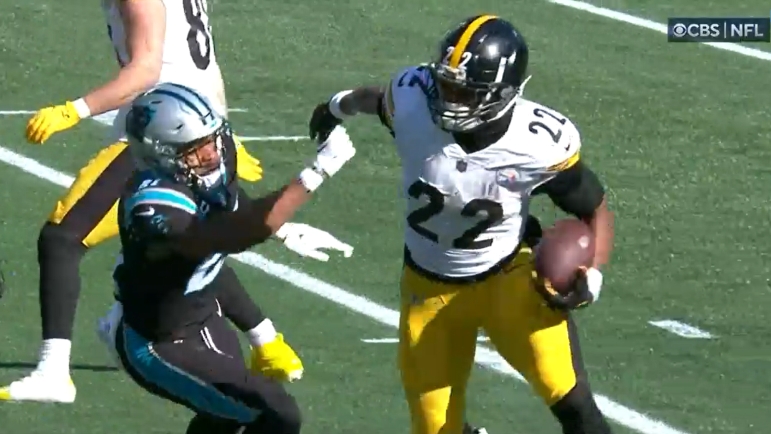Pittsburgh Steelers running back Najee Harris has been a polarizing player since he was drafted. On the one hand you have people who think he never should’ve been drafted in the first round as a running back. On the other hand, you have people who love him as a workhorse back who has shown he can handle a ton of touches while being a capable receiver out of the backfield.
One of the biggest complaints from many who watch Harris is his vision as sometimes it seems he may miss holes resulting in minimal gains. However, despite this perceived flaw one thing that has stuck out about him is that he does a good job of not losing yardage when given the ball. NFL analyst Warren Sharp tweeted about percentage of runs that went for one yard or fewer in 2022 and Harris graded out to be average with 26.5%. Of the players who had more ineffective runs, names like Nick Chubb and Saquon Barkley stand out.
Now, this is not to say Harris is a better running back than them or some others above him, nor is he worse than some of the backs below him. But what it does say is that he does a good job of not putting the team in bad spots for second or third down, and with an improved offensive line we should see those numbers improve even more. For Pittsburgh, avoiding these types of inefficient runs will keep their offense on schedule, critical to their 2023 success.
The Steelers offense did not set the world on fire last season by any means, but as the season progressed the team began to start sustaining drives which helped their cause. While they often did not end in a touchdown, the team was capable of driving close to field goal range and in the worst case scenario was able to flip the field. One reason for this was that Harris got healthy. Early in training camp last year, he suffered a Lisfranc sprain and began the season with a steel plate in his foot. After he removed it he started to play much better and as a result Pittsburgh’s offense began to improve.
Harris averaged 3.8 yards per carry last season, which needs to be better. Ideally, he will average over four yards per carry this season with the improvements made up front with the offensive line and his percentage of rushes fewer than one yard will decrease even more. This is important for a young Steelers offense who is relying on the run game, as last season they ran the ball on first down 37-percent of the time. While that is not an insane number, it may increase this season with an emphasis on running the football.
How does Harris avoiding negative plays help the Steelers’ offense breakout? If he can average about four yards per carry next season, Pittsburgh can average a second and medium each drive if they run it on first down most times. The Steelers were a sneaky good team on third down last year, finishing seventh in the NFL on third down conversions at 44.9-percent. However, as the run game and Harris improved as the season went on it got even better. In the final three weeks of the season the Steelers converted 53.3-percent of their third downs, second best in the NFL.
Pittsburgh struggled with explosive plays last season, with only 52, ranked just 26th in the league. They need to get into good positions early on first and second down to sustain drives. With quarterback Kenny Pickett in Year Two this should improve a bit, but I don’t think it will take a huge leap meaning that once again Pittsburgh will need to set themselves up nicely on first and second down. That is where Harris comes in as he rarely has negative plays and should improve this season given a better offensive line and health.
While Harris certainly has his flaws and will remain a polarizing player, he does do a good job of not setting Pittsburgh up in bad spots. Going into his third year he’s never been in a better situation as a player and because of this he should play a big part in helping the Steelers offense take off.








